Off-Beat: Did Galen Really Pioneer Diagnostic Use of the Pulse?
The internet presents a maelstrom of misinformation when it comes to ancient medicine. In this blog, Glyn debunks a claim about an important ancient medical author: Galen. He examines several older biological texts to refute that Galen was the first to use examination of the pulse in diagnosis.
Ancient medicine looms large in the popular imagination today. Such a healthy interest can sadly lead to the spread of misinformation if ancient source texts are not properly referenced and scrutinized. Helen King, professor emerita of the Open University, has recently devoted a book to this phenomenon. In Hippocrates Now (easily available in Open Access), she explores modern (mis)assumptions about the Greek physician Hippocrates, the ‘father of medicine’.
My contribution will also attempt to debunk a false claim about an ancient medical author, albeit not the elusive Hippocrates, but that other towering figure of ancient medicine: Galen (2nd c. CE), who has left behind a staggering amount of treatises that can be securely attributed to him. Born to an elite family in Pergamon (in modern day western Turkey), Galen eventually became the physician of several Roman emperors. He was one of the most prolific authors of antiquity (image 1) and treated a wide variety of subjects both medical and philosophical.
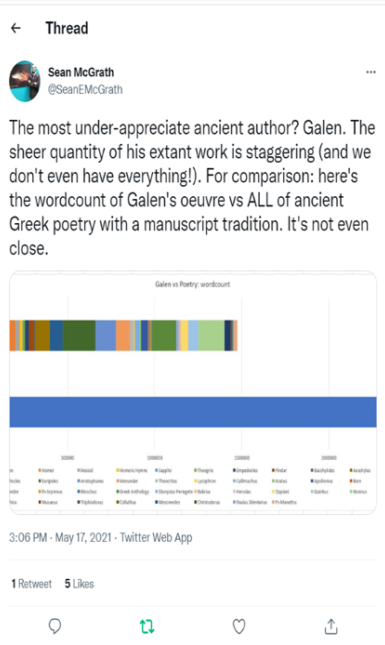
While googling around for material I may have missed for a chapter on the diagnostic uses of touch in ancient Greek scientific texts, I noticed several hits claiming that Galen was the first to recognize the importance of the pulse in diagnosis. We can read in the International Journal of Cardiology
that “Galen was the first to use the pulse as a sign of specific illnesses,” (Pasipoularides 2014, 47). A contribution to the Journal of Evolution of Medical and Dental Sciences claims that “Galen pioneered diagnostic use of the pulse rate” (Ajita 2015, 4512). In a blog post for medium.com intriguingly titled ‘The Greatest Surgeon in History Was Terribly Mistaken’ Galen is mentioned to have “[…] created new procedures, including critical basics like using our pulse to measure illness”. A website on ‘temperament theory’ copyrighted in 1995 states that “Galen was the first to consider the pulse a diagnostic aid”. On the Wikipedia page for the pulse, too, we find that “Claudius Galen was perhaps the first physiologist to describe the pulse”, with an incomplete reference to historian of medicine Owsei Temkin.
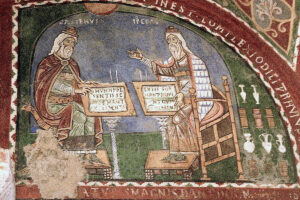
To put it bluntly, Galen was not the first to use the pulse in diagnosis, not by a long shot. Leaving aside the question of what ‘first’ means here (I limit myself to the Greek scientific context, but the ancient Chinese physician Chunyu Yi had already developed a refined system for pulse diagnosis in the second century BCE; Lloyd 2020 compares his case histories to Hippocratic and ancient Egyptian examples), several Greek medical authors had already considered the diagnostic usefulness of the pulse by the third century BCE. That said, none of this is meant as a slap on the wrist of these medical scholars and bloggers. They can be forgiven for thinking Galen was the first to propagate pulse diagnosis by the sheer number of treatises in his extant corpus devoted to the pulse (see the appendix in Nutton 2020), ranging from Pulses for Beginners to The Use of the Pulse. Furthermore, as Orly Lewis (2016) has demonstrated, taking the pulse was by Galen’s time the sine qua non of the encounter between doctor and patient: Galen’s older contemporary Marcellinus—who himself authored a treatise on the pulse—even writes that laymen were wont to take their own pulse (Marcellin. Puls. 3-4; Lewis 2016: 347)! Pulse lore was incredibly popular in Galen’s day.
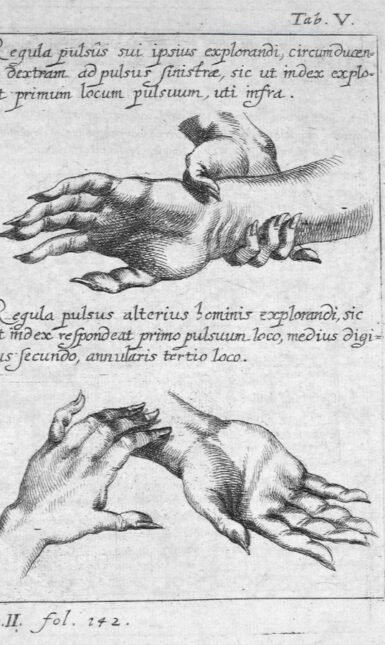
But what exactly do we mean by pulse? In modern biology, the pulse refers to the arterial pulse. In short, arteries are the vessels that carry the oxygen rich blood pushed out by the contracting heart to the rest of the body. The heart chambers draw in new blood, and this is pushed out again—the heart ‘beats,’ and the arteries dilate in agreement with this beat when the heart pumps new blood into them. The pulse represents a number of heartbeats within a minute and is usually measured at the wrist. If the pulse of a patient differs from the regular pulse this indicates that something might be amiss.
No ancient account of the pulse corresponds exactly to this modern scheme (for the final sections of this post I draw from the overview of ancient pulse lore in Von Staden 1989, 262-288). The Hippocratics, for starters, do not connect a regular beating of blood vessels to the heart at all. We encounter in these treatises terms such as palmós
(παλμός) and sphygmós (σφυγμός, which later became the standard word for the pulse), both meaning ‘palpitation’ and not usually connected to blood vessels or considered to be a regular function of the body. In fact, they are both nearly always pathological symptoms of disease. The author of the treatise Places in Man (5th
c. BCE) is the only Hippocratic to mention blood vessels that “always pulsate” (Loc. Hom. 3) due to the collision of two movements of blood, but this refers to a specific pair of vessels in the head that press upon the eyes.
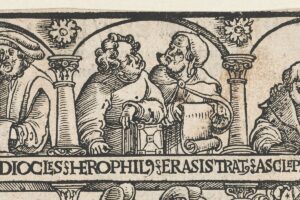
Instead, ancient pulse lore is usually associated mainly with the physician Herophilus of Chalcedon (active in the early 3rd c. BCE in Alexandria) and his teacher Praxagoras of Cos. Through his anatomical experiments, Herophilus developed a remarkably detailed theory of the arterial pulse. In order to properly measure the pulse, he isolated a primary time unit and used this to define regular pulse rhythms for patients from different age categories. Marcellinus (Herophil. T182 Von Staden 1989) gives the only detailed account of Herophilus’ pulse diagnosis in action. Using a water clock, Herophilus would take the pulse of a patient and note by how many beats the pulse exceeded the regular number for that age category in the time it took the water clock to empty. He used this measurement to judge the intensity of a fever.
Before Herophilus, however, Aristotle (4th c. BCE) had already argued that all blood vessels in the body have a continuous beat, and he even connected this to the heart. According to Aristotle, the heart acts as a pump under the influence of moisture drawn in from food, heating it and generating blood. The heart swells and is then cooled down again by the air drawn into the lungs, expelling the moisture into the bodies’ vessels (Herophilus thought that the pulse in the arteries was rather the result of a kind of power passed on from the heart to the arteries). Although Aristotle doesn’t go into detail about diagnostic uses of the pulse, he does state that regular pulsation should be differentiated from an abnormal concentration of heat in the heart “in the disease called palmós” (Resp. 20.479b).
We can conclude that once pulsation becomes a regular bodily function, it is possible to pathologize deviances from it as symptoms of disease. This holds true for Aristotle and Herophilus, but also for the Hippocratic author of Places in Man: even though the pulsation in the pair of veins in the head he discusses is not connected to the heart, it is continuous, which means that a lack of pulsation at least implicitly has diagnostic significance. Centuries before Galen, then, Greek science writing was concerned, both explicitly and implicitly, with the diagnostic use of the pulse. We can thus answer the title question of this blog post with a resounding ‘no.’
References and further reading
Note: all online sources were last accessed on 30-6-2022.
Ajita, Rajkumari. 2015. "Galen and his contribution to anatomy: a review." Journal of Evolution of Medical and Dental Sciences 4, no. 26 (March), 4509-4516. DOI: 10.14260/jemds/2015/651.
Cardenas, Diana. 2013. “Let not thy food be confused with thy medicine: The Hippocratic misquotation.” e-SPEN Journal 8, no. 6 (December), 260-262. https://doi.org/10.1016/j.clnme.2013.10.002
King, Helen. 2019. Hippocrates Now: The ‘Father of Medicine’ in the Internet Age. London: Bloomsbury Publishing.
Lewis, Orly. 2016. “The Practical Application of Ancient Pulse-Lore and its Influence on the Patient-Doctor Interaction.” In Homo Patiens: Approaches to the Patient in the Ancient World, edited by Georgia Petridou and Chiara Thumiger, 345-364. Leiden; Boston: Brill.
Lewis, Orly 2017. Praxagoras of Cos on Arteries, Pulse and Pneuma: Fragments and Interpretation. Leiden; Boston: Brill.
Lloyd, Geoffrey E. R. 2020. “A Return to Cases and the Pluralism of Ancient Medical Traditions.” In Medicine and Markets in the Graeco-Roman World and Beyond: Essays on Ancient Medicine in Honour of Vivian Nutton, edited by Rebecca Flemming and Laurence M. V. Totelin, 71-86. Swansea: Classical Press of Wales.
Nutton, Vivian. 2020. Galen: a thinking doctor in imperial Rome. Abingdon; New York: Routledge.
Pasipoularides, Ares. 2014. “Galen, father of systematic medicine. An essay on the evolution of modern medicine and cardiology.” International Journal of Cardiology 172, no. 1 (March): 47-58. https://doi.org/10.1016/j.ijcard.2013.12.166
Staden, Heinrich von. 1989. Herophilus: The Art of Medicine in Early Alexandria. Cambridge: Cambridge University Press.
© Glyn Muitjens and Leiden Arts in Society Blog, 2022. Unauthorised use and/or duplication of this material without express and written permission from this site’s author and/or owner is strictly prohibited. Excerpts and links may be used, provided that full and clear credit is given to Glyn Muitjens and Leiden Arts in Society Blog with appropriate and specific direction to the original content.


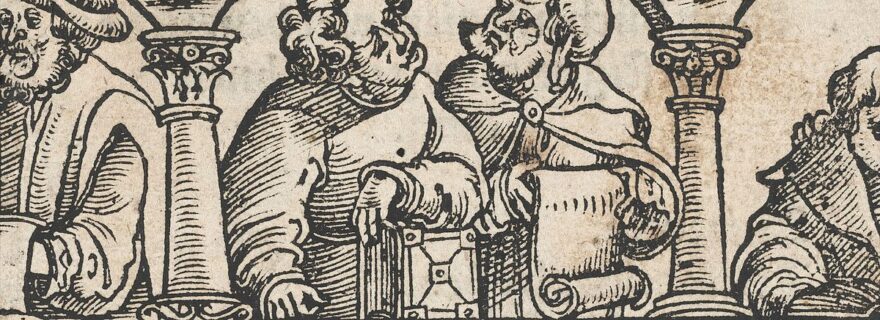
0 Comments